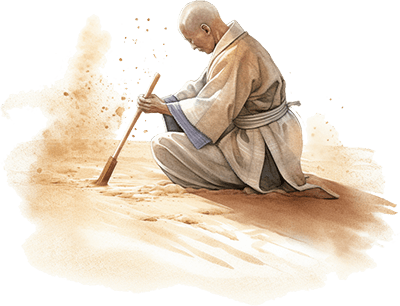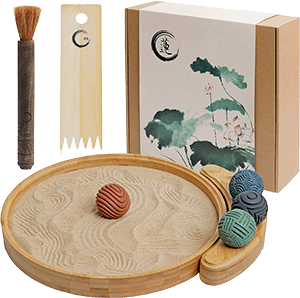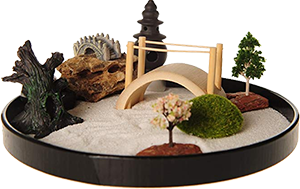The Art of Raking Patterns in Mini Zen Gardens: Traditional and Modern Techniques explained
Among the various elements that make up a Zen garden, one of the most crucial and intriguing aspects is the art of raking patterns. These patterns, carefully crafted by the gardener (or the user of a mini zen garden), are not only aesthetically pleasing but also hold great importance in the practice of Zen.
Importance of raking patterns in Zen gardens
Raking patterns in Zen gardens are believed to represent the flow of water, waves, and even the winds blowing through a landscape. In traditional Japanese gardens, the sand or gravel is raked to create patterns that are meant to represent various natural elements. These patterns are often intricate and can take hours to create, requiring patience and precision.
In Zen philosophy, the process of raking patterns can be seen as a form of meditation. By focusing on the task at hand, the gardener enters a state of mindfulness, allowing their mind to become fully present in the moment. The act of raking also helps to promote relaxation and reduce stress, making it a popular activity for those seeking a moment of calm in their busy lives.
While the traditional patterns in Zen gardens are steeped in symbolism and history, modern raking patterns have also emerged, providing new creative avenues for gardeners to explore. These patterns often incorporate geometric shapes and abstract designs, allowing for a more personalized expression of individual creativity.
In addition to the aesthetic appeal of raking patterns, they also play a practical role in Zen gardens. By raking the sand or gravel regularly, the gardener helps to maintain the cleanliness and order of the garden, ensuring that it remains a peaceful and serene space.
Whether you are looking to create a traditional or modern Zen garden, raking patterns are an essential element that cannot be overlooked. They hold great significance in Zen philosophy, promoting mindfulness and relaxation, while also serving a practical purpose in garden maintenance. In the following sections, we will delve deeper into traditional and modern raking patterns, exploring their meanings and how to create them in your own mini Zen garden.
Traditional Raking Patterns in Zen Gardens
The art of raking patterns in Zen gardens has been practiced for centuries in Japan and is an important aspect of Japanese culture. In traditional Zen gardens, the raked patterns are intended to represent natural elements, such as water, waves, or mountains. These patterns have deep meanings and symbolism and are often associated with Buddhist philosophy.
Karesansui
The most common traditional raking pattern is the “Tsukubai” or “Karesansui” pattern. This pattern consists of concentric circles around a central point and is meant to represent ripples in water. The circle represents a single drop of water that causes ripples that extend outwards, symbolizing the interconnectedness of all things.
Crisscross
Another common traditional raking pattern is the “Kikyaku-gaki” or “Crisscross” pattern. This pattern is created by raking diagonal lines that intersect at right angles, creating a grid-like pattern. This pattern is meant to represent the conflict and harmony between opposing forces, such as good and evil, light and dark.
Grid
The “Tatami-gaki” or “Grid” pattern is another traditional raking pattern that consists of horizontal and vertical lines that create a grid-like pattern. This pattern is meant to represent the tatami mats commonly used in Japanese homes and is a symbol of order, balance, and harmony.
How to create traditional raking patterns
Creating traditional raking patterns in a mini Zen garden requires patience and attention to detail. To create the patterns, you will need a rake, typically made of bamboo or wood, and sand or gravel. Begin by raking the sand or gravel flat and smooth, then start creating the pattern by raking in the desired direction. The patterns can be created using straight lines, circles, or a combination of both, depending on the desired effect.
In addition to their aesthetic appeal, traditional raking patterns in Zen gardens serve a deeper purpose. They are intended to encourage mindfulness and promote a sense of tranquility and calmness. By focusing on the act of raking, the gardener can enter a meditative state and connect with the natural world.
Now that you understand the significance and meaning behind traditional raking patterns, in the next chapter, we will explore modern raking patterns in Zen gardens and how they differ from traditional ones.
Modern Raking Patterns in Zen Gardens
While traditional raking patterns in Zen gardens have a deep-rooted significance and symbolism, modern raking patterns offer a new creative avenue for gardeners to explore. Modern patterns often incorporate geometric shapes and abstract designs, allowing for more personal expression and creativity.
Spiral
One popular modern raking pattern is the “Spiral” pattern, which features a continuous spiral that extends outward from the center of the garden. This pattern is meant to symbolize the journey of life, with the spiral representing the twists and turns one may encounter along the way.
Checkerboard
Another popular modern raking pattern is the “Checkerboard” pattern, which features a grid-like pattern created by alternating dark and light-colored sand or gravel. This pattern is meant to represent the balance between opposing forces and the need for harmony in our lives.
Abstract
The “Abstract” pattern is another modern raking pattern that allows for complete creative expression. This pattern can take on any form, from random lines and shapes to intricate designs, and is meant to represent the infinite possibilities of life.
How modern raking patterns differ from traditional ones?
Modern raking patterns differ from traditional ones in their approach to symbolism and meaning. While traditional patterns have specific meanings and symbolism associated with them, modern patterns often leave room for personal interpretation and expression. Modern patterns also tend to incorporate more abstract designs and concepts, whereas traditional patterns focus on natural elements.
When choosing a raking pattern for your mini Zen garden, consider your personal preferences and intentions behind the garden. Do you want to create a sense of harmony and balance, or do you want to express your creative side? Understanding your intention behind the garden will help you choose the right pattern that aligns with your goals.
Creating modern raking patterns
Creating modern raking patterns in a mini Zen garden requires a similar approach to traditional patterns. Start by raking the sand or gravel flat and smooth, then use the rake to create the desired pattern. The key is to let your creativity flow and experiment with different designs until you find one that resonates with you.
In the next chapter, we will explore the considerations when choosing a raking pattern and how to experiment with different patterns to create a unique and personal Zen garden.
Choosing the Right Raking Pattern for Your Mini Zen Garden
When choosing a raking pattern for your mini Zen garden, consider these points:
Your Personal Preferences: Your personal taste and preferences should be the primary factor in choosing a raking pattern for your mini Zen garden. Consider the patterns that resonate with you and your goals for the garden.
The Intended Meaning: If you are looking to create a specific message or convey a particular meaning through your garden, you may want to choose a traditional raking pattern that aligns with that message. Alternatively, you may choose a modern pattern that allows for personal expression and creativity.
The Size and Shape of the Garden: The size and shape of your garden can also impact the choice of raking pattern. A larger garden may be able to accommodate more intricate and complex patterns, while a smaller garden may require simpler patterns.
The Natural Elements Surrounding the Garden: Consider the natural elements surrounding your garden, such as rocks or trees, and choose a pattern that complements or contrasts with these elements.
Once you have considered these factors, it’s time to experiment with different raking patterns to find the one that works best for your garden. Start by creating a simple traditional pattern, such as the “Parallel” or “Wave” pattern, and then move on to more complex designs. Take your time and enjoy the process of creating a unique and personal Zen garden.
When raking the patterns, it’s essential to use the right tools and techniques. You will need a rake that is the appropriate size for your garden and the pattern you want to create. You can find more information on our article: best mini Zen garden rakes.
Start by raking the sand or gravel flat and smooth, then use the rake to create the desired pattern. Take your time and move slowly, focusing on the present moment and the pattern taking shape beneath your hands. If you make a mistake, don’t worry, you can always smooth out the sand and start again.
In the next chapter, we will explore the techniques for raking patterns in mini Zen gardens and tips for achieving a perfect raking pattern.
Techniques for Raking Patterns in Mini Zen Gardens
Here are some tips to help you get started:
Use the Right Tools: As we mentioned in the previous chapter, you will need a rake that is the appropriate size for your garden and the pattern you want to create. A smaller rake is better for intricate patterns, while a larger rake is better for more extensive patterns.
Start with a Smooth Surface: Before you start raking, make sure the surface of your garden is flat and smooth. You can use a small trowel or your hands to level the sand or gravel.
Choose a Starting Point: Choose a starting point for your pattern, and use your rake to create the first lines. It’s important to move slowly and deliberately to create a precise and intentional pattern.
Use Both Hands: To create intricate patterns, you will need to use both hands to control the rake. Use your dominant hand to guide the rake, while your non-dominant hand stabilizes the rake and helps create the pattern.
Stay Focused: Raking a pattern in a Zen garden can be a meditative practice. To stay focused and present, take deep breaths and focus on the sensation of the rake in your hands and the sand or gravel beneath it.
Experiment with Different Patterns: Don’t be afraid to experiment with different patterns to find the one that works best for your garden. You can also combine traditional and modern patterns to create a unique design that aligns with your personal preferences and goals.
Practice Patience: Creating a raking pattern in a Zen garden requires patience and practice. Don’t worry if your first attempts are not perfect. Keep practicing, and with time, you will develop the skill and precision to create beautiful and meaningful patterns.
By using these techniques and tips, you can create a unique and beautiful raking pattern in your mini Zen garden that aligns with your personal preferences and goals. Remember, the process of raking the pattern can be a meditative and calming practice that promotes relaxation and stress relief.
In the final chapter, we will explore the connection between raking patterns and mindfulness and how they can promote relaxation and stress relief.
Using Raking Patterns for Mindfulness and Relaxation
Raking patterns in a Zen garden is not only an aesthetic pursuit but also a meditative one. The process of raking a pattern can be a mindful and calming practice that promotes relaxation and stress relief. Here are some techniques for using raking patterns in your mini Zen garden for mindfulness and relaxation:
Slow Down and Be Present: When you rake a pattern in your Zen garden, slow down and be present in the moment. Focus on the sensation of the rake in your hands and the sound of the sand or gravel moving beneath it. Take deep breaths and allow your mind to relax.
Embrace Imperfection: Raking a pattern in a Zen garden can be a practice of letting go of perfectionism. Allow yourself to make mistakes and embrace imperfection. This practice can help you let go of the need for control and promote feelings of ease and relaxation.
Use Raking as a Moving Meditation: Raking a pattern in a Zen garden can be a moving meditation that promotes mindfulness and relaxation. As you rake, focus on the sensations in your body and the present moment. Allow yourself to let go of any worries or stress and focus solely on the pattern.
Experiment with Different Raking Patterns: Experimenting with different raking patterns can be a creative and mindful practice that promotes relaxation and stress relief. Try different patterns and see how they make you feel. You may find that certain patterns promote feelings of calm and relaxation, while others may stimulate your creativity and energy.
Use Raking Patterns as a Tool for Reflection: Raking patterns in a Zen garden can also be a tool for self-reflection and introspection. As you rake, think about your intentions and goals. What do you hope to achieve? What obstacles are in your way? Reflecting on these questions can help you gain clarity and insight.
Incorporating raking patterns into your mini Zen garden can be a mindful and calming practice that promotes relaxation and stress relief. By slowing down, embracing imperfection, and experimenting with different patterns, you can use raking as a tool for mindfulness and reflection.




